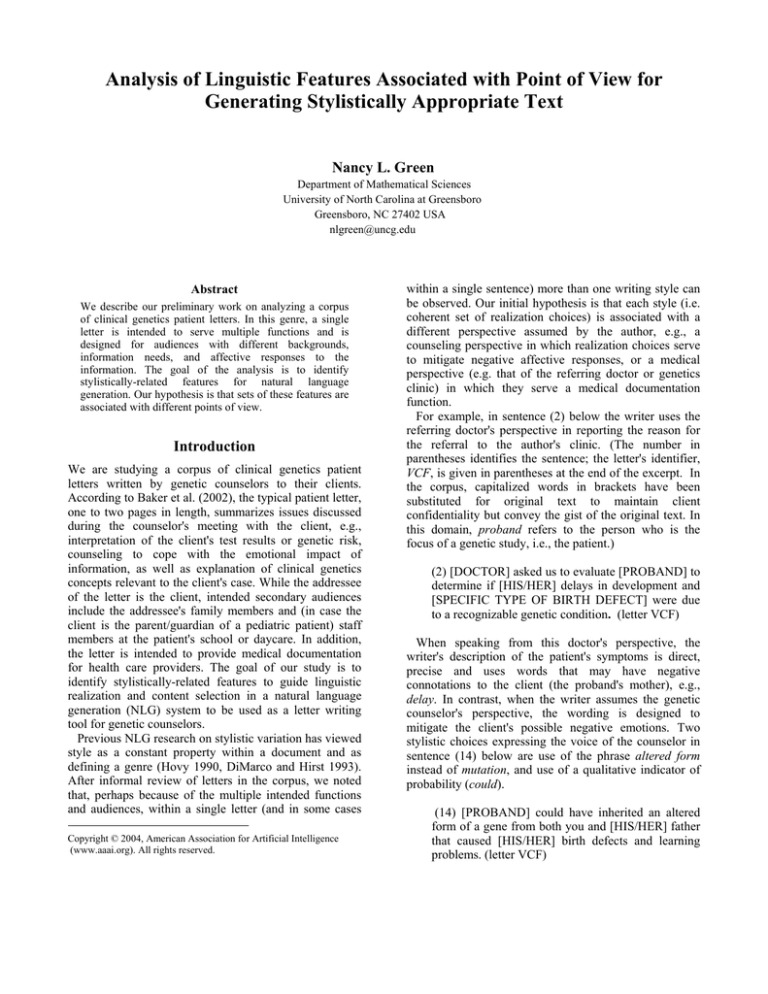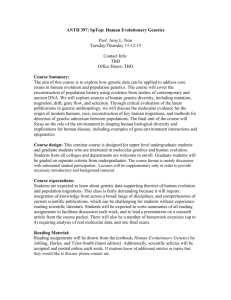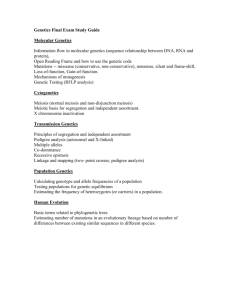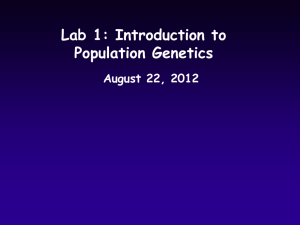
Analysis of Linguistic Features Associated with Point of View for
Generating Stylistically Appropriate Text
Nancy L. Green
Department of Mathematical Sciences
University of North Carolina at Greensboro
Greensboro, NC 27402 USA
nlgreen@uncg.edu
Abstract
We describe our preliminary work on analyzing a corpus
of clinical genetics patient letters. In this genre, a single
letter is intended to serve multiple functions and is
designed for audiences with different backgrounds,
information needs, and affective responses to the
information. The goal of the analysis is to identify
stylistically-related features for natural language
generation. Our hypothesis is that sets of these features are
associated with different points of view.
Introduction
We are studying a corpus of clinical genetics patient
letters written by genetic counselors to their clients.
According to Baker et al. (2002), the typical patient letter,
one to two pages in length, summarizes issues discussed
during the counselor's meeting with the client, e.g.,
interpretation of the client's test results or genetic risk,
counseling to cope with the emotional impact of
information, as well as explanation of clinical genetics
concepts relevant to the client's case. While the addressee
of the letter is the client, intended secondary audiences
include the addressee's family members and (in case the
client is the parent/guardian of a pediatric patient) staff
members at the patient's school or daycare. In addition,
the letter is intended to provide medical documentation
for health care providers. The goal of our study is to
identify stylistically-related features to guide linguistic
realization and content selection in a natural language
generation (NLG) system to be used as a letter writing
tool for genetic counselors.
Previous NLG research on stylistic variation has viewed
style as a constant property within a document and as
defining a genre (Hovy 1990, DiMarco and Hirst 1993).
After informal review of letters in the corpus, we noted
that, perhaps because of the multiple intended functions
and audiences, within a single letter (and in some cases
Copyright © 2004, American Association for Artificial Intelligence
(www.aaai.org). All rights reserved.
within a single sentence) more than one writing style can
be observed. Our initial hypothesis is that each style (i.e.
coherent set of realization choices) is associated with a
different perspective assumed by the author, e.g., a
counseling perspective in which realization choices serve
to mitigate negative affective responses, or a medical
perspective (e.g. that of the referring doctor or genetics
clinic) in which they serve a medical documentation
function.
For example, in sentence (2) below the writer uses the
referring doctor's perspective in reporting the reason for
the referral to the author's clinic. (The number in
parentheses identifies the sentence; the letter's identifier,
VCF, is given in parentheses at the end of the excerpt. In
the corpus, capitalized words in brackets have been
substituted for original text to maintain client
confidentiality but convey the gist of the original text. In
this domain, proband refers to the person who is the
focus of a genetic study, i.e., the patient.)
(2) [DOCTOR] asked us to evaluate [PROBAND] to
determine if [HIS/HER] delays in development and
[SPECIFIC TYPE OF BIRTH DEFECT] were due
to a recognizable genetic condition. (letter VCF)
When speaking from this doctor's perspective, the
writer's description of the patient's symptoms is direct,
precise and uses words that may have negative
connotations to the client (the proband's mother), e.g.,
delay. In contrast, when the writer assumes the genetic
counselor's perspective, the wording is designed to
mitigate the client's possible negative emotions. Two
stylistic choices expressing the voice of the counselor in
sentence (14) below are use of the phrase altered form
instead of mutation, and use of a qualitative indicator of
probability (could).
(14) [PROBAND] could have inherited an altered
form of a gene from both you and [HIS/HER] father
that caused [HIS/HER] birth defects and learning
problems. (letter VCF)
In summary, we hypothesize that in addition to a
representation of what must be said, our NLG system
must be provided with a specification of perspective in
order to be able to generate stylistically appropriate text
in this application. We have identified a set of potential
perspectives. Next, we plan to manually annotate the
corpus for perspective and candidate linguistic features,
and then apply analysis techniques to identify
correspondences. This paper justifies our hypothesis by
outlining a set of perspectives and some of the features
potentially associated with each that we have identified
by qualitative analysis so far.
Perspectives in Corpus
Based upon our review of letters in the corpus1 and on
information about genetic counseling, e.g. (Wilson 2000),
we have identified the following perspectives:
• author: the letter writer, writing on behalf of the
genetics clinic; although this role is performed by the
genetic counselor, we shall distinguish this
perspective from that of the genetic counselor. (ex.
This letter will summarize…, We hope this
information is helpful…)
• client: person(s) who met with the counselor and
principal addressee(s) of letter; usually the proband
or a member of the proband's family. (ex. You
expressed concern that …)
• referring doctor: doctor who referred the patient to
the clinic; usually not a member of the clinic staff.
(ex. [DOCTOR] asked us to evaluate … )
• clinic: genetics clinic that tested the patient; the
writer/genetic counselor is a member of the clinic
staff. (ex. We obtained a blood sample …)
• genetic counselor: the genetic counselor who met
with the client(s). (ex. It is important to remember
that [PROBAND'S] problems could still be caused by
genetic alteration.)
• educational: basic background knowledge about
clinical genetics as portrayed in text books for health
care professionals. (ex. In some instances, children
… inherit two copies of an altered gene…)
• research: research information on clinical genetics,
i.e., newer or more specialized than the educational
perspective. (ex. Individuals with VCF often have ...)
Although originally developed for the automated
analysis of narrative (Wiebe 1994), and later applied to
analysis of attitude in newspaper articles (Wilson and
Wiebe 2003), the model of psychological point of view
(POV) provides a framework for our own study. That
model defines a private-state relation whose components
include an experiencer, an attitude, and the object of the
1
Currently, the corpus contains 16 patient letters given to
us by genetic counselors and a letter published in (Baker
et al., 2002); we are continuing to collect more letters.
private state. For example in sentence (2, VCF) repeated
below, the experiencer, identified as [DOCTOR], is the
referring doctor, the attitude could be interpreted as
believes it to be possible that, and the object corresponds
to what is expressed as the proband's delays in
development and [SPECIFIC TYPE OF BIRTH
DEFECT] were due to a recognizable genetic condition.
(2) [DOCTOR] asked us to evaluate [PROBAND] to
determine if [HIS/HER] delays in development and
[SPECIFIC TYPE OF BIRTH DEFECT] were due
to a recognizable genetic condition.
(3) During your appointment on [DATE], we
obtained a blood sample from [PROBAND]
(4a) In addition to the routine chromosome study,
(4b) in which a microscopic study of the 46
chromosomes is done,
(4c) a special analysis of the long arm of
chromosome 22 (22q11)
(4d) by a technique called fluorescence in situ
hybridization (FISH)
(4e) was done to test for Velocardiofacial syndrome
(VCF).
(5) Individuals with VCF often have [SPECIFIC
TYPE OF BIRTH DEFECT] and learning problems.
(letter VCF)
This excerpt illustrates several other points. First, as
noted in (Wiebe 1994), experiencer and attitude need not
be stated explicitly. In (3), the experiencer, signalled by
we, is the clinic and the attitude could be interpreted as
knowledge shared by experiencer and addressee. In (4),
the experiencer could be interpreted as the clinic again,
although it was not explicitly signalled; (4) continues
(Wiebe 1994) the experiencer of the current POV. The
second point illustrated is how subtle differences in
attitude can be signalled by both content selection and
wording. In contrast to how we interpreted the attitude in
(3), we claim that the explanatory information provided in
(4b) and (4d) suggests that attitude in those phrases
should be represented something more like, knowledge
that the experiencer believes the addressee does not have.
This change in attitude is associated with a shift in tense;
the explanatory information in (4b) and (4d) is presented
in the present tense while the rest of (2) through (4), a
narration of the patient's history and clinic visit, is
presented in the past tense. Finally, according to our
interpretation the experiencer in (5) is the research
perspective, rather than the preceding experiencers in this
excerpt, namely, the referring doctor and clinic. This
change in experiencer is marked also by a shift to the
present tense.
Identifying Associated Features
Table 1 (at the end of the paper) shows for each
perspective defined above, some candidate associated
features that we have identified by manual inspection of
the corpus. The second column provides a brief
description of semantic criteria for identifying
perspective. The third column lists the typical forms used
for referring to each type of experiencer when explicitly
given. Note that first person plural pronoun forms
(abbreviated as 1p-plural in the table) such as 'we' may be
used to refer to several categories of experiencer. The
fourth column lists characteristic forms for conveying
probability, and is discussed in the following section. The
last column lists several other types of possible features.
Probability
In a previous study of this corpus (Green 2003), we
manually tagged both qualitative and quantitative
indicators of probability and frequency. Examples of
qualitative indicators are modal verbs (e.g. can, could)
and frequency adverbs (e.g. often) and quantifiers (e.g.
many). Quantitative indicators are phrases including
numbers, e.g. about 1 in every 3000, and approximately
80%.. That study determined that the ratio of probability
statements to the number of sentences was high, which is
not surprising due to the inherent uncertainty in diagnosis
and prediction in clinical genetics.
Table 1 (column four) shows the probability indicators
that seem to be associated with each perspective. As can
be seen, the use of probability indicators characterizes
several perspectives. However, indicators that we refer to
as Mendelian numbers in the table, i.e. idealized ratios
that characterize a Mendelian inheritance model such as
1/4, 1/2, and 3/4 (which can be expressed as percentages
also), seem to be associated with the educational
perspective. Other numeric indicators not characteristic of
the Mendelian model seem to be associated with the
research perspective. For example, in sentences (4) and
(7) of letter NF in the corpus, which present a research
perspective, the probability indicators (underlined) use
non-Mendelian numbers:
(4) Neurofibromatosis 1 (NF) is a progressive disorder
of the skin and nervous system that occurs in about 1 in
every 3000 individuals.
(7) Approximately 80% of individuals affected with
NF have mild to moderate symptoms. (letter NF)
However, as illustrated by (5) in letter VCF above, the
writer may use a qualitative indicator (often) even when
speaking from a research perspective.
The tagged probability indicators were used in (Green
2003) to encode conditional probability statements
conveyed in the text. For example, (7, letter NF) could be
paraphrased as
P("mild to moderate symptoms" | NF)
= "approximately 80%".
In this case, the POV notions of object and attitude
overlap with what we were attempting to characterize
then; the attitude corresponds to the belief that the
probability is approximately 80%, and the object
corresponds to the belief encoded on the left hand side of
this equation. However, the POV notion of attitude is
broader than what we were characterizing in that work.
For example, as illustrated in our discussion of sentence
(4, letter VCF) above, attitude may encompass the
distinction between shared and non-shared knowledge.
Mitigating Negative Affective Responses
According to writing guidelines for genetic counselors
(Baker et al. 2002), writers should consider possible
negative emotional effects (grief, fear, shame, etc.) that
information in a letter may have on the client; the
guidelines therefore suggest using "non-stigmatizing",
"value-free" language, e.g. alteration instead of mutation.
The corpus shows that the writers often do employ this
strategy, especially when writing from the counseling or
educational perspective. However, it seems that the
writers do not always follow this strategy when writing
from the referring doctor's or research perspective (what
we refer to as use of technical genetics/medical words in
Table 1). It is plausible that use of these technical words
is required in some cases to achieve the medical
documentation function.
Also, Baker et al. (2002) describe a number of writing
strategies in this genre for managing "distance" between
patient and information, between the staff and
information, or between the staff and the patient. To
increase distance between the patient and information that
might be viewed negatively by the patient, one
recommended strategy is to state the information in
general terms instead of in terms of the patient, e.g.,
Children with this condition tend to lose their hearing,
instead of Nisha is likely to lose her hearing. We have
observed this strategy in the corpus, but we represent it as
a shift from the genetic counselor perspective to the
educational perspective. This is reflected in Table 1 in the
features in column five called reference to population and
universal, as opposed to the feature called direct
reference to proband/family.
Conclusion
We identified a set of perspectives and some of the
features potentially associated with each in a corpus of
genetic counseling patient letters. Our goal is to analyze
how perspective is reflected in linguistic realization and
content selection options for natural language generation.
Acknowledgments
This work is supported by the National Science
Foundation under CAREER Award No. 0132821.
References
Baker, D.L., Eash, T., Schuette, J.L., and Uhlmann, W.R.
2002. Guidelines for Writing Letters to Patients. Journal
of Genetic Counseling 11(5):399-418.
DiMarco, C. and Hirst, G. 1993. A Computational Theory
of Goal-Directed Style in Syntax. Computational
Linguistics. 19(3):451-500.
Experiencer
Topics
author
about letter,
greetings, closing
issues brought up by
client at meeting
client
referring
doctor
genetics
clinic
genetic
counselor
reason for referral to
clinic, symptomsfindings, candidate
diagnosis
clinic visit,
procedures/tests
performed, results
interpretation of
results or risk,
recommendations
background
information about
clinical genetics
Reference to
experiencer
pronoun (1p-plural)
proband/family by
name or pronoun
(2p 3p)
doctor by name
Green, N. 2003. Towards an Empirical Model of
Argumentation in Medical Genetics. In Proceedings of
IJCAI 2003 Workshop on Computational Models of
Natural Argument, 39-44.
Hovy, E. 1990. Pragmatics and Natural Language
Generation. Artificial Intelligence 43:153-197.
Wiebe, J. M. 1994. Tracking Point of View in Narrative.
Computational Linguistics 20( 2):233-288.
Wilson, T. and Wiebe, J. 2003. Annotating Opinions in
the World Press. In Proc. of 4th SIGDial Workshop.
Wilson, G.N. 2000. Clinical Genetics: A Short Course.
New York: Wiley-Liss.
Probability
"this letter", formulaic language (e.g. "it
was a pleasure ")
"you asked whether"
indirect (e.g.
"due to")
pronoun (1p-plural)
pronoun (1p-plural)
Other cues
"[DOCTOR] asked us" , "referred by
[DOCTOR] to", past tense, technical
genetics/medical words
past tense
qualitative,
Mendelian
numbers
qualitative,
Mendelian
numbers
emphasis ("still", "it is important"), valuefree genetics/medical words, direct
reference to proband/family
value-free genetics/medical words,
educational
reference to population (e.g. "the
parents") or universal (e.g. "we",
"everyone")
research
research information
qualitative,
technical genetics/medical words,
on clinical genetics
quantitative
reference to population (e.g.
"Individuals"), present tense
Table 1. Preliminary table of features. The righthand three columns list some candidate linguistic features associated with
perspective in first column. The second column provides semantic criteria for identifying perspective.







